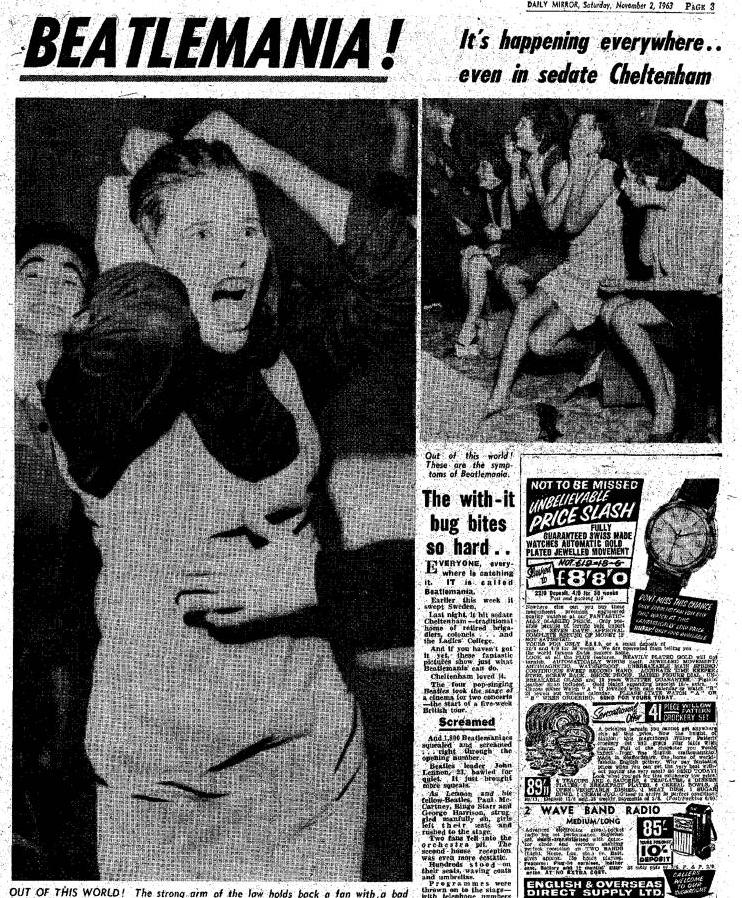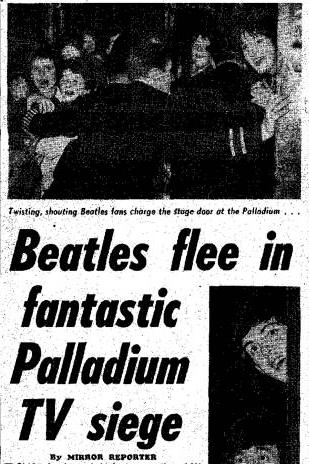Brow Beat is following the Beatles in “real time,” 50 years later, from their first chart-topper to their final rooftop concert. Fifty years ago this month, the Beatles played one of their biggest concerts yet, prompting journalists to cover “Beatlemania” for the first time.
The Beatles had been driving fans into squealing fits of hysteria for months, but it’s only in October 1963 that “Beatlemania” was born. While the symptoms were nothing new—Elvis’ jittery hips had shook forth similar sounding shrieks almost a decade before, and the Beatles had done it even as an opening band—it’s only in October 1963 that journalists began to look upon the frenzied droves and make a now familiar diagnosis: Beatlemania.
Who was the first to diagnose the phenomenon? Many historians, perhaps following Wikipedia’s lead, have suggested that the word was first coined by a mid-October article in the Daily Mirror. However, a search through the Mirror’s archive (subscription only) reveals that the word didn’t appear in its pages until Nov. 2, when the headline screamed “BEATLEMANIA!” and noted, “It’s happening everywhere… even in sedate Cheltenham.” The article was certainly notable for its insistence, proclaiming, “Everyone, everywhere is catching it.” And it ended with a provocative detail: “Programmes were thrown on the stage—with telephone numbers written on them in lipstick…”

Photo by Forrest Wickman
But the actual first printed use of the word seems have appeared instead in The Daily Mail, which on October 21 ran a feature by Vincent Mulchrone under the headline “This Beatlemania.” The Mail may have heard the term elsewhere—Andi Lothian, who booked the Beatles in concert, claims that he coined the term speaking to a reporter in Scotland a couple weeks earlier. Or the writers and editors may have been thinking of “Lisztomania,” the phenomenon first noted by poet and critic Heinrich Heine, which described similar behavior among fans of the 19th century pianist Franz Liszt. (“How convulsively his mere appearance affected them!” Heine wrote. “How boisterous was the applause which rang to meet him! … A veritable insanity, one unheard of in the annals of furore!”)
Regardless, the Beatles’ breakout concert in the U.K.—the one that them a regular fixture on the nation’s front pages—is no subject of controversy: It was the Beatles’ Oct. 13 performance on Val Parnell’s Sunday Night at the London Palladium. In the U.K., the show was as big as Ed Sullivan (which the Beatles wouldn’t play until months later), and drew up to 15 million viewers a night, and the Beatles were the headliners. The band, for their part, didn’t hold back, playing No. 1 hits “From Me to You” and “She Loves You,” “She Loves You” b-side “I’ll Get You,” and their rollicking version of “Twist and Shout.” The sound quality isn’t great, but you can listen to the whole performance below.
Though reviews were positive, it wasn’t the Beatles’ performance that made headlines. As you can hear in the recording, they were hardly even able to hear themselves. At one point Lennon, trying to make himself heard enough to announce their closing number, told fans to “Shut up!” (You can hear this at the 7:45 mark above.) Later he said that the music “might as well have been us farting.”

Photo by Forrest Wickman
The real scene was outside the concert, where “more than 1,000 screaming teenagers” kept the Beatles locked up in a “day-long siege,” as the Mirror described it. As the Beatles figured out how to make an exit, fans fought to break through “a cordon of more than 60 police officers.” The Mirror’s account was no more sensational than the others. According to the Daily Herald, “screaming girls launched themselves against the police—sending helmets flying and constables reeling.” Presenter Val Parnell, for his part, told the Beatles that afternoon, “I am not risking letting you out. It could be dangerous.”
Eventually the Beatles decided that, with crowds mobbing the stage door, they would do what fans least expected. After road manager Neil Aspinall pulled around the car, they made a break for it out the main entrance, as fans who had caught on chased after.
This would soon become a common scene in the media, but in October 1963 the press was just beginning to catch on. The next month, Pathé News, “by generous permission of their famous manager Brian Epstein,” released a full 6-minute color film on the frenzy, called The Beatles Come to Town. Crowds only grew, and “Beatlemania” became a regular topic in the press for years to come.
Read more from Blogging the Beatles
Before the British Invasion, a Beatle Comes to America
The Beatles Say Goodbye to the Cavern Club
Quiz: Who Wrote It, Lennon or McCartney? The With the Beatles Edition
How Lennon and McCartney Wrote “She Loves You”
Quiz: Who Wrote It, Lennon or McCartney? Please Please Me Edition
When John Lennon Was Simon Cowell
The Beatles Overtake Their Idols
The Beatles Get Their Own Show
Did John Lennon Have a Secret Affair With Brian Epstein?